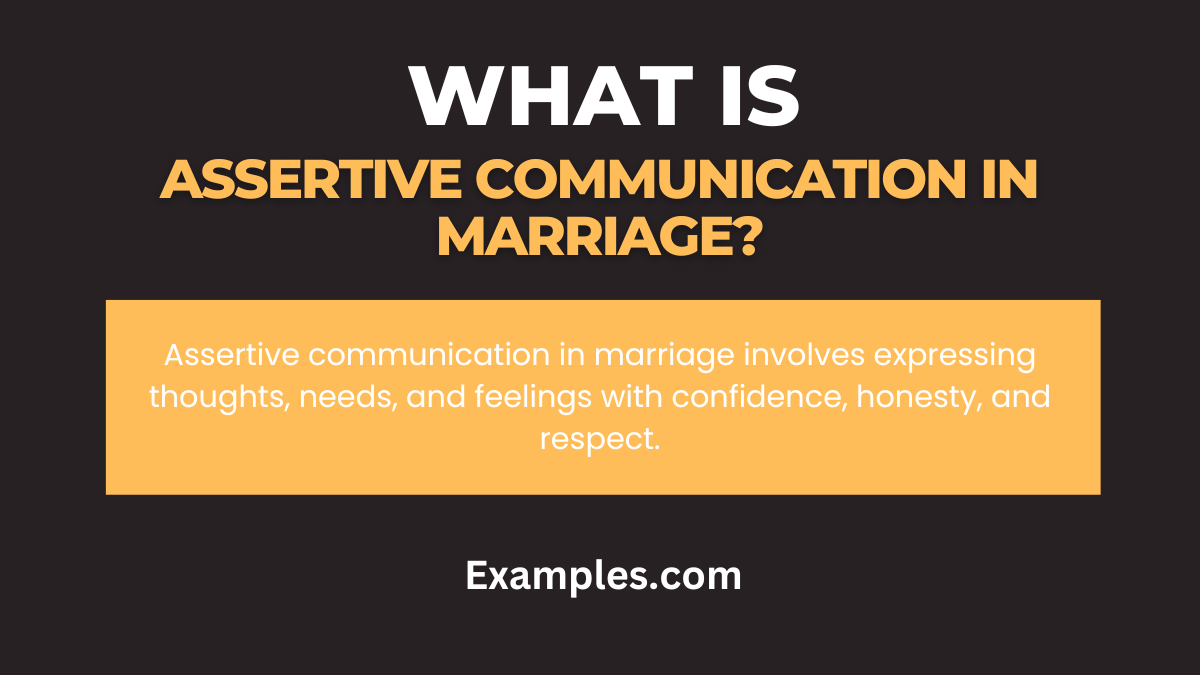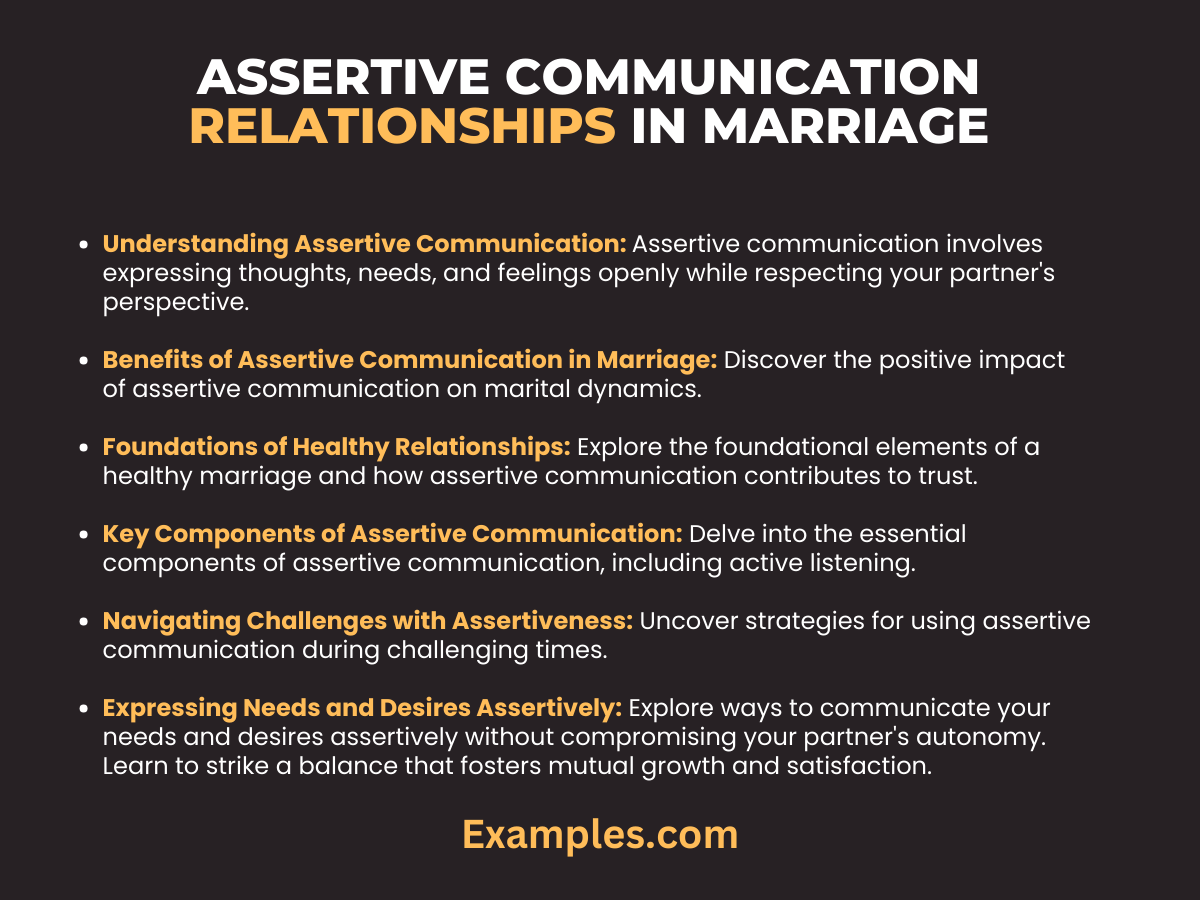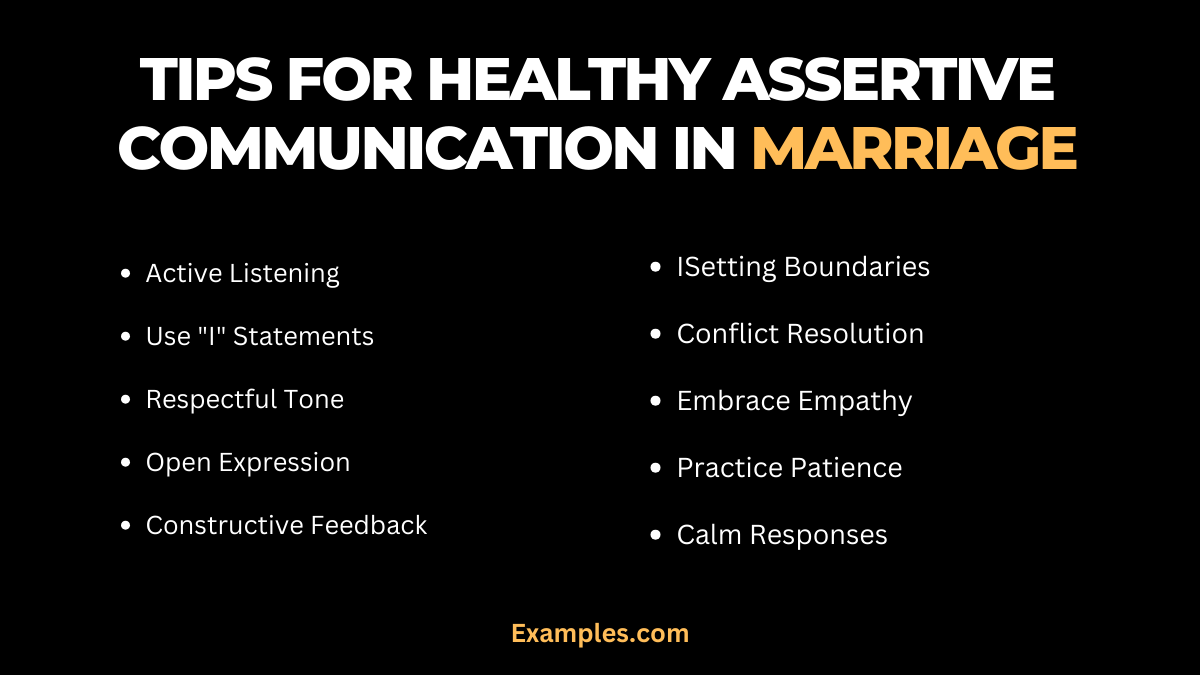29+ Assertive Communication in Marriage Examples
Embark on a journey through the intricate tapestry of Communication – from its nuanced definition to the fascinating historical origins. Explore vivid examples and uncover the evolution that shapes our interactions. Dive into practical “How-to” insights and valuable tips, illuminating the art of effective communication. This comprehensive guide empowers you with the knowledge to navigate the diverse realms of human connection with finesse and skill. Unleash the potential of meaningful dialogue for personal and professional triumphs.
What is Assertive Communication in Marriage?

Assertive communication in marriage involves expressing thoughts, needs, and feelings with confidence, honesty, and respect. It fosters open dialogue, contributing to a healthy, thriving relationship where both partners feel heard and valued. Understanding the essence of assertive communication lays the foundation for effective marital interactions and the resolution of conflicts with mutual respect and understanding.
30 Examples for Assertive Communication in Marriage
Unlock the power of assertive communication in your marriage with these impactful examples. Embrace clarity, expressiveness, and empathy to strengthen your bond.
- Expressing Needs: Clearly articulate your needs, ensuring mutual understanding and responsiveness.
Example: Requesting more quality time together. - Setting Boundaries: Establish healthy boundaries for personal space and shared responsibilities.
Example: Agreeing on alone time for personal hobbies. - Constructive Feedback: Provide and receive feedback with a positive approach, fostering growth.
Example: Discussing ways to improve household chores. - Respecting Differences: Acknowledge and respect each other’s unique perspectives and preferences.
Example: Understanding diverse opinions on family decisions. - Negotiating Compromises: Find middle ground through compromise, ensuring both perspectives are considered.
Example: Deciding on weekend plans that accommodate both partners’ preferences. - Active Listening: Demonstrate attentive listening, validating your partner’s thoughts and emotions.
Example: Giving full attention during a discussion about future goals. - Resolving Conflicts Calmly: Address disagreements calmly and constructively, avoiding escalation.
Example: Discussing financial concerns without blaming each other. - I-Statements: Use “I feel” statements to express emotions without placing blame, encouraging understanding.
Example: Communicating feelings about a stressful day. - Empathy in Disagreements: Acknowledge your partner’s feelings even when you disagree, fostering empathy.
Example: Validating emotions during a difference of opinion. - Sharing Responsibilities: Collaborate on household tasks, ensuring a fair distribution of responsibilities.
Example: Coordinating chores to lighten the workload for both. - Positive Affirmation: Offer genuine compliments and affirmations, nurturing a positive atmosphere.
Example: Expressing appreciation for small gestures. - Direct Communication: Be straightforward and honest in your communication, promoting transparency.
Example: Communicating directly about personal feelings. - Non-Verbal Assertiveness: Use body language to convey confidence and assurance in your expressions.
Example: Maintaining eye contact during serious discussions. - Solution-Oriented Approach: Focus on finding solutions rather than dwelling on problems, promoting problem-solving.
Example: Brainstorming ideas to overcome a shared challenge. - Firm Boundary Setting: Clearly define and communicate personal boundaries, ensuring mutual understanding.
Example: Discussing the importance of personal space and privacy. - Respecting Emotional Space: Allow each other emotional space during challenging times, avoiding pressure.
Example: Giving space during moments of stress for individual reflection. - Handling Criticism Gracefully: Receive constructive criticism gracefully, fostering an environment of improvement.
Example: Accepting feedback on communication habits. - Open and Honest Expression: Encourage open and honest sharing of thoughts and feelings, building trust.
Example: Discussing personal fears or insecurities openly. - Conflict Resolution Strategies: Adopt effective strategies to resolve conflicts peacefully and constructively.
Example: Using “time-out” strategies during heated discussions. - Effective Time Management Talks: Discuss and plan schedules collaboratively to manage time effectively.
Example: Organizing shared calendars for better coordination. - Sharing Opinions Respectfully: Express opinions respectfully, considering each other’s viewpoints.
Example: Discussing differing views on parenting approaches. - Requesting Support: Seek support when needed, fostering a sense of unity and partnership. Example: Requesting emotional support during challenging times.
- Celebrating Achievements Together: Acknowledge and celebrate each other’s accomplishments, reinforcing positivity.
Example: Celebrating personal and professional achievements. - Addressing Unfairness: Discuss perceptions of fairness in the relationship, ensuring an equitable partnership. Example: Addressing concerns about an uneven distribution of responsibilities.
- Giving Personal Space: Respect the need for personal space, recognizing the importance of independence.
Example: Allowing solo time for hobbies or individual pursuits. - Clarifying Misunderstandings: Address misunderstandings promptly, preventing unnecessary conflicts.
Example: Clarifying intentions behind a misunderstood comment. - Communicating Needs Confidently: Assertively communicate your needs without fear, promoting a supportive atmosphere.
Example: Expressing the need for emotional reassurance. - Handling Financial Conversations: Approach financial discussions calmly, planning and budgeting together.
Example: Discussing long-term financial goals and strategies. - Expressing Love and Affection: Verbalize love and affection regularly, nurturing emotional connection.
Example: Expressing love through random acts of kindness and sweet gestures. - Creating Shared Goals: Collaboratively set and work towards shared goals, fostering a sense of unity.
Example: Planning and working towards a mutual dream or aspiration.
Assertive communication relationships in marriage
Effective communication skills play a pivotal role in marital success. Explore the dynamics of assertive communication within relationships to foster understanding, empathy, and a healthy partnership.

- Understanding Assertive Communication: Assertive communication involves expressing thoughts, needs, and feelings openly while respecting your partner’s perspective. Learn the fundamentals to enhance mutual understanding.
- Benefits of Assertive Communication in Marriage: Discover the positive impact of assertive communication on marital dynamics. From conflict resolution to intimacy, explore how this skill cultivates a thriving relationship.
- Foundations of Healthy Relationships: Explore the foundational elements of a healthy marriage and how assertive communication contributes to trust, emotional intimacy, and a strong sense of partnership.
- Key Components of Assertive Communication: Delve into the essential components of assertive communication, including active listening, I-statements, and empathy, to build a strong foundation for effective marital dialogue.
- Navigating Challenges with Assertiveness: Uncover strategies for using assertive communication during challenging times. From disagreements to major life decisions, learn how to navigate obstacles with respect and clarity.
- Expressing Needs and Desires Assertively: Explore ways to communicate your needs and desires assertively without compromising your partner’s autonomy. Learn to strike a balance that fosters mutual growth and satisfaction.
- Constructive Feedback in Marital Communication: Master the art of providing constructive feedback within the context of marriage. Discover how feedback can strengthen your relationship and contribute to personal and shared development.
- Setting Boundaries and Respecting Limits: Understand the importance of setting and respecting boundaries in marriage. Learn how assertive communication enables couples to establish and honor each other’s limits.
- Conflict Resolution Through Assertiveness: Dive into effective conflict resolution strategies using assertive communication. Discover how to address disagreements, find compromises, and strengthen your connection in the process.
- Fostering Emotional Intimacy: Explore the role of assertive communication in fostering emotional intimacy. Learn how sharing vulnerabilities and expressing emotions assertively deepens the emotional connection in marriage.
Assertive communication skills in love marriage
In a love marriage, assertive communication is vital for sustaining a healthy relationship. This involves expressing thoughts and feelings openly and respectfully. Here’s a comprehensive guide:
- Active Listening: Practice attentive listening to understand your partner’s perspectives deeply.
- Use of ‘I’ Statements: Employ statements that begin with ‘I’ to express personal feelings without sounding accusatory.
- Empathy Building: Foster empathy by considering your partner’s emotions and viewpoints.
- Respectful Disagreement: Learn to disagree respectfully, appreciating diverse opinions without hostility.
- Non-Verbal Assertiveness: Utilize assertive body language, maintaining eye contact and confident posture.
- Conflict Resolution: Develop effective conflict resolution strategies for a harmonious relationship.
- Positive Affirmation: Provide positive affirmations to strengthen your emotional connection.
- Setting Boundaries: Clearly define and respect personal boundaries to ensure mutual understanding.
- Constructive Feedback: Offer constructive feedback to promote personal and collective growth.
- Calm and Composed Response: Respond calmly to challenging situations, fostering a peaceful environment.
Tips for Healthy Assertive Communication in Marriage
Assertive communication is a cornerstone of a strong marital relationship. Employing these techniques fosters understanding and strengthens the bond between partners. Here are effective tips for nurturing assertive communication within marriage:

- Active Listening: Ensure attentive and empathetic listening, offering undivided attention to your partner’s thoughts and feelings.
- Use “I” Statements: Express feelings, needs, and opinions using “I” statements, focusing on personal experiences without blaming.
- Respectful Tone: Maintain a respectful and calm tone, promoting an environment of mutual respect and understanding.
- Open Expression: Encourage an open and honest expression of thoughts and emotions, creating space for transparent communication.
- Constructive Feedback: Offer constructive feedback, focusing on behaviors or situations without criticizing the individual.
- Setting Boundaries: Establish clear boundaries regarding personal space, time, and individual needs while considering each other’s preferences.
- Conflict Resolution: Approach conflicts with a solution-oriented mindset, seeking compromises and resolutions that benefit both partners.
- Embrace Empathy: Cultivate empathy by understanding your partner’s perspective and validating their emotions.
- Practice Patience: Exercise patience and understanding, allowing space for growth and change within the relationship.
- Calm Responses: Respond calmly to disagreements or misunderstandings, avoiding escalations or heated arguments.
In conclusion, assertive communication in marriage is a vital skill that can enhance relationship dynamics, fostering mutual respect, understanding, and emotional intimacy. It involves expressing thoughts, needs, and feelings openly while respecting your partner’s perspective, contributing to a healthier and more satisfying marital relationship. This skill not only improves conflict resolution but also strengthens emotional connections between partners.
To delve deeper into the subject and enhance assertive communication in marriage, consider exploring these two authoritative resources:
- American Psychological Association (APA) Resource: The APA offers comprehensive insights into healthy relationships, including the role of assertive communication in marital success. This resource is invaluable for couples seeking to strengthen their communication and overall relationship health. Access this resource at APA’s Guide to Healthy Relationships.
- Psychology Today Article: This article provides practical tips for communicating more assertively in relationships. It is an excellent guide for couples looking to improve their assertive communication skills, offering strategies to address common challenges and enhance the quality of their interactions. Read more at Psychology Today’s Tips for Assertive Communication in Relationships.
These resources, from highly reputable sources, offer detailed and practical advice, making them invaluable for couples who wish to foster a stronger, more open, and respectful bond through assertive communication.



